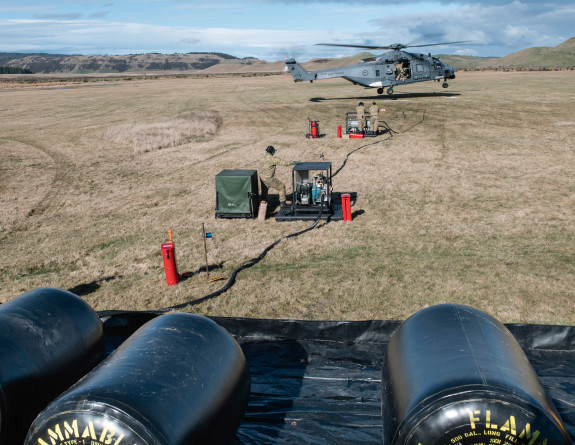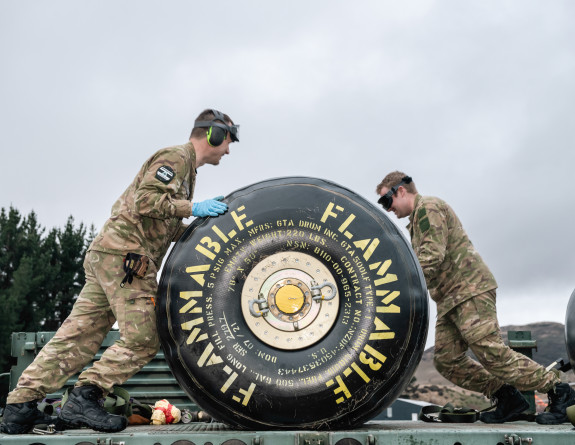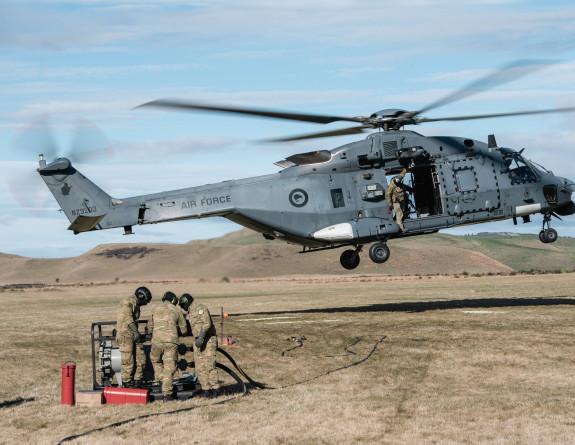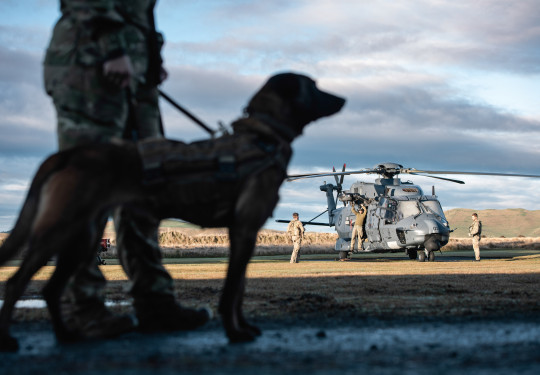Ground control at Exercise Steel Talon
The backbone of any Royal New Zealand Air Force exercise is the ground trades that support the aircrews.
01 July, 2022
Teams from No. 230 Squadron supply communication links and intelligence information, the armament team looks after weapons, maintainers are crucial in keeping the helicopters running in the austere environment and security forces protect the valuable assets.
Flying Officer (FGOFF) Ben Riedstra from Communications and Information Systems Flight said the unit was primarily there to provide information systems support.
“We set up the operations room with all the internal computer systems so the aircrew and intelligence can do planning and access email and all the normal things you do in an office environment.
The other side of what we do is set up communications support.
“We provide flight-follow to the aircraft, which includes search and rescue watch. They are contacting us every 30 minutes to tell us whenever they are at a point of interest, where they are and what their next intentions are, so if their aircraft was to go down, in scenario being shot down or in real life if it is lost, then we have an idea on where they are.”



The unit also set up the internet by running a 3G/4G system.
“Our communication with the aircraft is done by using high frequency, which has been used since World War II, it’s pretty reliable. All our communication with the aircraft is using encrypted high frequency, but we have a back-up system of military satellite communications, which uses a global satellite network, which bounces our comms down to the aircraft,” he said.
“The reason we are using two completely contrasting technologies, one very new, one very old, is because high frequency is very fussy with the atmospheric conditions and satellite communications are very finicky. We’ve got to plan and jump between frequencies and technologies to fine-tune what works best with the conditions and atmosphere and mission being undertaken.”
A No. 230 Squadron intelligence officer said the team supports the helicopter crews by keeping an eye on the environment they are operating in.
“In this case it’s any threats to the helicopter. That can be anything from geospatial threats, so knowing where the powerlines are, through to if there is a hostile force on the ground. We tell them what their capabilities are, what their intent might be to target us and potentially providing some recommendations to the crews on how we can reduce the hostile force’s opportunity to target us in a way that might harm our operations.”
The intelligence officer also works on creating the scenarios used in exercise.
“When we come up with these scenarios we don’t make up a totally fictional place, they are based on reality. We think about real scenarios we might deploy to or we have deployed to in the past or our partners’ forces might be deployed to. So we take a mixture of real elements,” she said.
Armament technician Corporal (CPL) Robert Kernohan said the team made use of a deployable armament container, attached to a Unimog.
“We issue guns out of there. We’ve got a weapon storage capability and a workshop set-up. Depending on the scenario depends on how many weapons we issue,” he said.
“We’ve got the machine guns – the MAG 58s for the NH90s – and the personal weapons, the Mars-L rifles and Glock pistols.
“As far as maintenance goes, if they bring back a broken weapon, we’ve got a small amount of supplies to be able to repair them,” CPL Kernohan said.
“The scenario we are training for is that we are supporting a partner nation. We are exercising as if we have been invited by a host country to provide security and logistic support for them.”
- Intelligence officer
Aircraft mechanic Aircraftman (AC) Sean van Sittert said it was important to keep up with the day-to-day maintenance and pre-checks of the helicopters, fixing any minor problems.
“The weather is a big issue in Waiouru, normally in Ohakea we have the helicopters in the hangars most of the time, so we don’t have to put on any tie-downs or anything or equipment to stop water or animals getting inside. We’ve got to make sure the wind doesn’t damage any of the blades, we need to keep them tied down.
“The other difference is we are limited on resources. We’ve brought what we can, but obviously we can’t get into in-depth maintenance while we are on a base like this where we don’t have all our stores. Which is exactly how it would be if we were deployed to a foreign nation,” AC van Sittert said.
Security Forces operator AC Jack Grundy said his main role was around aircraft security.
“Aircrew and maintainers can’t be out with the aircraft all night and that’s where we come in. The dog team is also here. They’ll come out and do work around the aircraft as well, as extra security.
“We are also participating in some of the smaller scenarios and exercises out in the field. We’re about to go out and do a scenario where the security forces team are either the enemy or friendly party.
